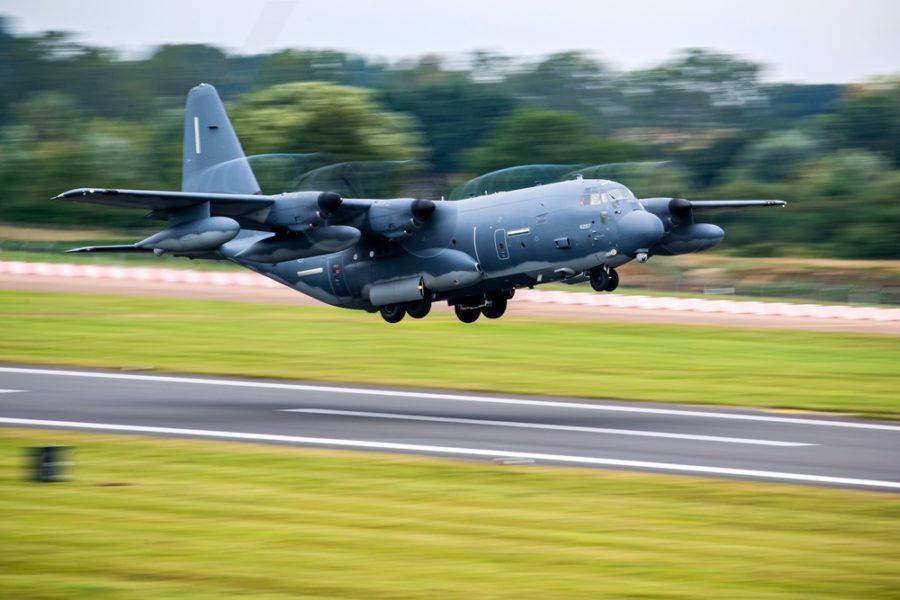The MC-130J is USAF’s next-generation special operations tanker/ mobility aircraft based on the C-130J. Designated Commando II (previously Combat Shadow II) in honor of the WWII C-47, the aircraft are tasked with covert day, night, and adverse weather infiltration, exfiltration, and resupply of special operations forces in hostile or denied territory.

They also provide airdrop resupply, rotary wing aerial refueling, psyops, and rubber raiding craft deployment for littoral ingress/egress.
Specialized mission systems include advanced, integrated defensive systems including LAIRCM, EO/IR targeting sensor, and an added CSO flight-deck station to manage refueling, tactical navigation, and comms.
MC-130Js are equipped with wing-mounted external tanks and drogue refueling pods to provision tilt-rotor and rotarywinged aircraft as well as a boom-style receptacle to receive fuel in flight.
The MC-130J shares system commonality with both the HC-130J rescue and AC-130J gunship versions, sharing overlapping upgrades and modernization with both types. The MC-130J was pulled out of baseline C-130J Block 7/8.1 software upgrades, which were then merged with comm/nav modernization in 2022. “Block 8.X” now comprises critical software for HF/VHF/UHF SATCOM upgrades, including secure, jam-resistant Mobile User Objective System (MUOS) BLOS and antijam NATO-interoperable SATURN UHF.
Link 16 mods were delayed for funding and a planned switch to high-capacity, jam-resistant MIDS-JTRS. AFSOC is significantly enhancing the MC-130J’s ability survive an operate in future high-end-threat environments under Capability Release 2, which includes Terrain-Following/ Terrain Avoidance (TF/TA) radar, Radio Frequency Countermeasure (RFCM), and Airborne Mission Networking (AbMN).
Upgraded aircraft are redesignated Combat Talon III and will pave the way toward future open-architecture, highly integrated, and automated mission and defensive systems. Silent Knight TF/TA is housed in a second radome below the cockpit and enables the MC-130J to fully replace the MC-130H in the low-level nighttime/adverse weather penetration role. RFCM modernizes EW, improves detection, location, and response to emerging threats, while AbMN gives the aircrew a common air/ground picture to manage complex workloads. Modernization also includes the radar warning receivers, chaff, and flare systems.
AFSOC delayed demonstrating a float-equipped MC-130J for nonrunway operations to 2026 but is pushing forward with prototyping, testing, and evaluation. The final legacy MC-130H retired on April 10, 2023, and AFSOC is also divesting the EC-130J to consolidate its C-130-based special mission fleet.
Contractors: Lockheed Martin (airframe); Boeing; Sierra Nevada Corp. (RFCM).
First Flight: April 20, 2011.
Delivered: Sept. 29, 2011-present.
IOC: Dec. 7, 2012.
Production: 59 (planned).
Inventory: 54.
Operator: AETC, AFSOC.
Aircraft Location: Cannon AFB, N.M.; Kadena AB, Japan; Kirtland AFB, N.M.; RAF Mildenhall, U.K.
Active Variants: •MC-130J. New-build aircraft based on the standard-length fuselage C-130J.
Dimensions: Span 132.6 ft, length 97.8 ft, height 38.8 ft.
Weight: Max T-O 164,000 lb.
Power Plant: Four Rolls-Royce AE2100D3 turboprops, each 4,591 shp.
Performance: Speed 416 mph, range 3,000 miles (further with air refueling).
Fuel Capacity: 61,360 lb at 150-300 gpm (100 gpm dual, simultaneous refueling).
Ceiling: 28,000 ft with 42,000-lb payload.
Accommodation: Two pilots, CSO, two loadmasters.
Load: 42,000 lb of cargo/personnel (see C-130J for configurations).

